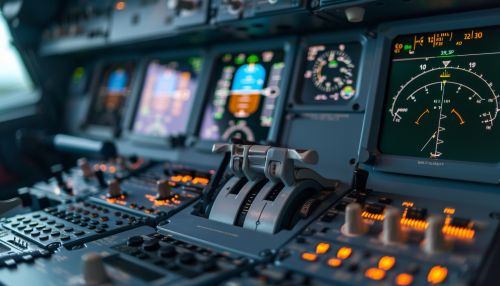Autopilot
Overview
An autopilot is a system used to control the trajectory of an aircraft, ship, or other vehicle without constant 'hands-on' control by a human operator. Autopilots do not replace human operators, but instead, they assist them in controlling the vehicle, allowing them to focus on broader aspects of operation, such as monitoring the trajectory, weather and systems.
History
The development of the autopilot was initially motivated by the need to make long-distance air travel feasible. The first aircraft autopilot was developed by Sperry Corporation in 1912. The autopilot connected a gyroscopic heading indicator and attitude indicator to hydraulically operated elevators and rudder. It permitted the aircraft to fly straight and level on a compass course without a pilot's attention.
Principles of Operation
Autopilots in modern complex aircraft are three-axis and generally divide a flight into taxi, takeoff, ascent, level, descent, approach, and landing phases. Autopilots exist that automate all of these flight phases except the taxiing. An autopilot-controlled landing on a runway and controlling the aircraft on rollout (i.e. keeping it on the center of the runway) is known as a CAT IIIb landing or Autoland, available on many major airports' runways today, especially at airports subject to adverse weather phenomena such as fog.


Components
Autopilots are made up of several components. These include the controller, which contains the programming that tells the autopilot how to behave, the actuator, which physically moves the aircraft's controls, and the gyros, which provide the autopilot with information about the aircraft's current attitude.
Types of Autopilots
There are two major types of autopilots: single-axis (also known as "wing levelers") and two- or three-axis. Single-axis autopilots control an aircraft's roll. Two- or three-axis autopilots control roll, pitch, and sometimes yaw.
Applications
Autopilots are used in a variety of vehicles, including aircraft, spacecraft, missiles, and ships. They are used to maintain a set course, altitude, and speed, or to automatically land a vehicle.
Advantages and Disadvantages
The main advantage of autopilots in modern aircraft is the reduction of pilot fatigue. Autopilots are capable of maintaining an aircraft's course and altitude for extended periods of time, allowing the pilot to focus on other tasks. However, reliance on autopilots can also lead to complacency and decreased situational awareness.
Future Developments
The future of autopilot systems lies in the development of fully autonomous vehicles. These vehicles would not require a human operator and could make decisions based on a variety of sensors and complex algorithms.
